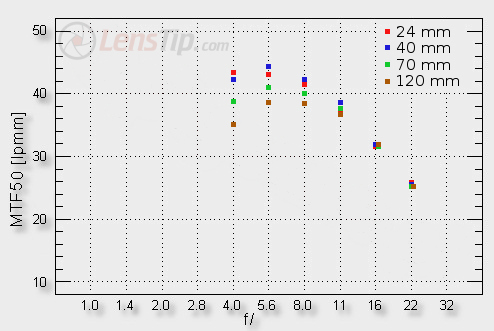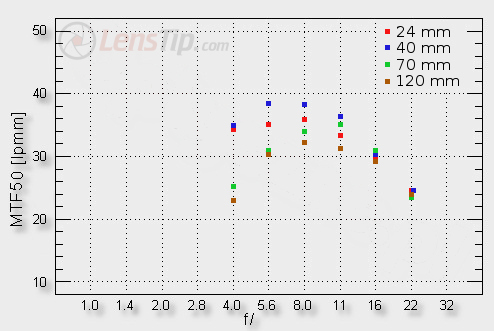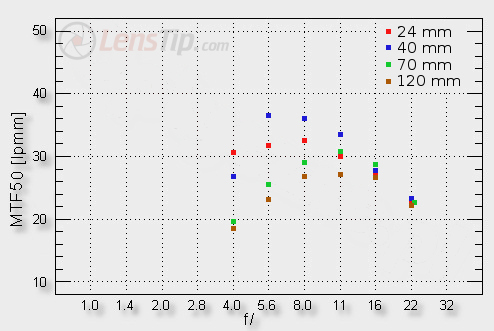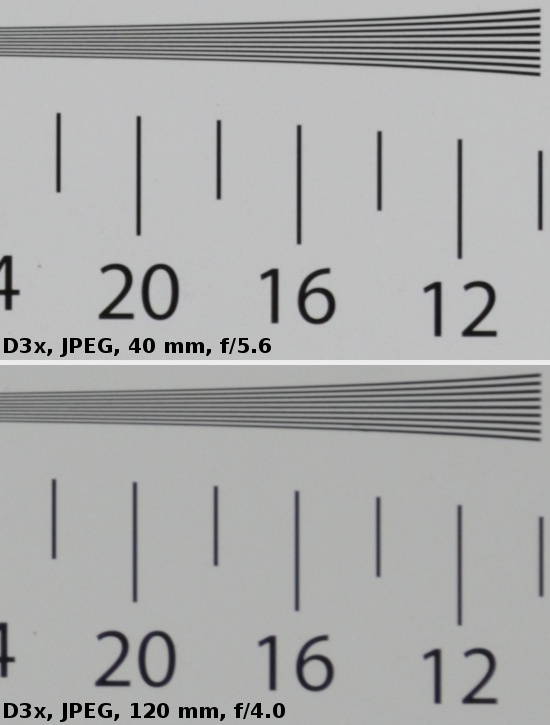Nikon Nikkor AF-S 24-120 mm f/4G ED VR
4. Image resolution

For a full frame 5x zoom instrument, including also a quite wide angle of view, these results are very good indeed. The performance in the 24-40 mm range would be difficult to fault. Even at the maximum aperture the results you get are splendid, because you can’t describe the level of 42-44 lpmm otherwise. The longer focal lengths are a bit worse. The maximum relative aperture lags behind significantly here but still the values of 35-39 lpmm are definitely above the decency level and on stopping down by 1 EV we can reach near 40 lpmm. Practically we have no reasons to criticize anything.
Let’s check the situation on the edge of the DX sensor using the graph below.
Please Support UsIf you enjoy our reviews and articles, and you want us to continue our work please, support our website by donating through PayPal. The funds are going to be used for paying our editorial team, renting servers, and equipping our testing studio; only that way we will be able to continue providing you interesting content for free. |
- - - - - - - - - - - - - - - - - - - - - - - - - - - - - - - - - - - - - - - - - - - - - - - -

Like in the frame centre, the lens presents itself definitely better at shorter focal lengths. In their case even by f/4.0 the results we get are good (near 35 lpmm). Stopping down the aperture is much more helpful at 40 mm than at 24 mm but there are no problems at both these focal lengths anyway. In the range of 70-120 mm the situation is a bit different – the maximum relative aperture is problematic there, only averagely useful according to our standards. If we want to obtain sharp images we must use f/5.6 or something near it. As a matter of fact the situation of the Canon 24-105 mm f/4L was very similar. Its performance in the frame centre was also splendid but on the edge of the APS-C sensor at longer focal lengths it had issues especially at the maximum relative aperture.
At the end we should describe the lens’s performance on full frame. The appropriate graph is presented below.

As you see the performance that was observed as the beginning of problems on the edge of the smaller sensor, becomes here very evident. What’s interesting, at the maximum relative aperture only at the widest angle there will be no issues whatsoever. At 40 mm we land a bit below the decency level but the image quality improves very quickly on stopping down so already by f/4.5 the decency level is reached. The worst performance we notice in the 70-120 mm range. Unfortunately you will be forced to stop down by over 2 EV to get a fully acceptable image there.
It becomes clear that producing a full frame zoom lens with parameters providing a very high image quality in the whole range of focal lengths and across the sensor is very difficult indeed.
At the end we present the crops of our test chart taken from JPEG files, saved along with RAW files.
 |






